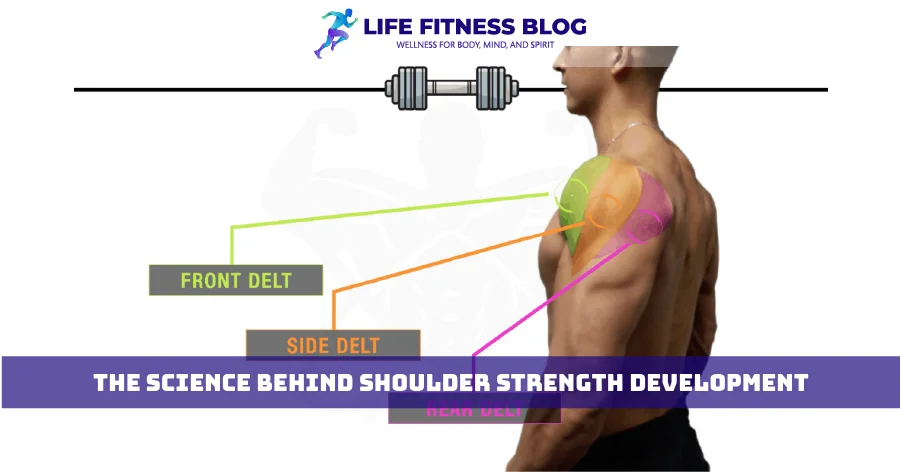Strong, stable shoulders are key for a strong upper body, good posture, and less injury risk. Whether you’re into sports, fitness, or just want to move better, the right shoulder exercises can make a big difference. This article will explain how to build strong shoulders and show you the 7 best workouts to boost your training.
Your shoulders are vital for many movements, like overhead lifts and pushing and pulling. Adding these shoulder workouts to your routine will improve your stability, and athletic skills, and make your body more resistant to injury.
Table of Contents
Understanding Shoulder Anatomy and Movement Patterns
To get the most out of your deltoid training and rotator cuff strengthening, knowing the shoulder’s anatomy is key. This joint has several muscle groups that work together. They help with a wide range of shoulder exercises and movements.
Deltoid Muscle Group Functions
The deltoid muscle has three parts: the anterior (front), middle, and posterior (rear) deltoids. These parts are vital for shoulder movements like abduction, flexion, and extension. By focusing on each part with different exercises, you can train your deltoids effectively.
Rotator Cuff Components
The rotator cuff is made up of four muscles: supraspinatus, infraspinatus, teres minor, and subscapularis. These muscles work together to keep the shoulder stable and mobile. They help with internal and external rotation, as well as arm abduction and adduction.
Range of Motion Considerations
Keeping the shoulder’s range of motion healthy is important for good shoulder exercises and overall health. Flexibility, joint mobility, and muscle balance all affect the shoulder’s range. Exercises that focus on these areas can improve your shoulder’s function and lower injury risk.
| Muscle Group | Primary Functions |
|---|---|
| Deltoid | Abduction, Flexion, Extension |
| Rotator Cuff | Internal Rotation, External Rotation, Abduction, Adduction |
Understanding the shoulder’s anatomy and movement patterns helps you create better deltoid training and rotator cuff strengthening routines. This leads to better shoulder stability, strength, and performance.

Essential Equipment for Effective Shoulder Training
To get the most out of your shoulder workouts, you need the right gear. Dumbbells, resistance bands, and more can help target different parts of your shoulders. They also make your workouts more interesting.
Dumbbells
Dumbbells are great for shoulder exercises because they let you work each side separately. They’re perfect for overhead presses, lateral raises, and more. This helps even out your shoulder strength.
Barbells
Barbells are best for big shoulder exercises like the military press. They add weight and stability, helping you get stronger. But, it’s important to use them correctly to work your shoulders right.
Resistance Bands
Resistance bands are a special tool for shoulder workouts. They keep tension in your muscles as you move. They’re great for lateral raises and other exercises that target your back deltoids and rotator cuff.
Cable Machines
Cable machines are a key part of your shoulder training. They let you move smoothly and focus on specific muscles. Try seated shoulder raises and standing cable upright rows to work different parts of your deltoids.
Using a variety of equipment in your shoulder workouts is key. It helps you build strength, stability, and balance. It also helps prevent injuries and keeps your muscles in check.
The Science Behind Shoulder Strength Development
To build strong shoulders, you need to know how muscles work. It’s about using fast-twitch and slow-twitch fibers and increasing weight over time. Learning this science helps you get stronger and avoid injuries.
Muscle Fiber Recruitment
Shoulder muscles, like the deltoids and rotator cuff, have different fibers. Fast-twitch fibers help with quick power, while slow-twitch fibers are for endurance. Training both types makes your shoulders strong and flexible.
Progressive Overload Principles
Getting stronger shoulders means using more weight or reps over time. This keeps your muscles growing. It’s a way to make your shoulders stronger and more stable.
Recovery and Adaptation
Rest and nutrition are as important as working out. They help your muscles recover and get stronger. This way, you avoid injuries and keep getting stronger.
Knowing how to train your shoulders is key. Use these tips to make your shoulders powerful and stable. Start now and see the difference.

7 Best Shoulder Workouts for Strength and Stability
Having strong, stable shoulders is key for a strong upper body. Whether you want to build muscle, improve your posture, or avoid injuries, the right shoulder exercises are essential. Let’s look at seven top-shoulder workouts for better strength and stability.
- Barbell Overhead Press: This classic exercise targets the deltoids, focusing on the front and middle heads. It’s important to use proper form and increase the weight to see the best results.
- Dumbbell Lateral Raises: These exercises target the middle deltoids, helping to achieve a “capped” shoulder look. It’s crucial to use the right technique and control the movement to avoid using momentum.
- Face Pulls: Face pulls mainly work the rear deltoids and upper back. They improve shoulder stability and posture by strengthening the rear delts, which are often overlooked.
- Standing Overhead Dumbbell Extensions: This exercise focuses on the long head of the triceps. It’s important for overhead pressing and shoulder stability.
- Landmine Press: The landmine press combines the push press with the challenge of a single-arm movement. It leads to well-rounded deltoid development.
- Band Pull-Aparts: Using resistance bands, these exercises target the rear deltoids and upper back. They help improve shoulder blade retraction and posture.
- Seated Dumbbell Shoulder Press: This exercise works for the entire deltoid muscle group. The seated position adds core stability and isolates the shoulder joint.
Adding these seven shoulder exercises to your workout routine can help you build strength and stability. It also helps achieve the balanced, defined shoulders you want. Always focus on proper form, increase the weight gradually, and make sure to rest enough for the best results.
Overhead Press Variations for Maximum Gains
To boost your shoulder strength and stability, try different overhead press exercises. Learning the right form for these exercises can help your deltoids grow stronger and bigger. This leads to significant gains in muscle size and strength.
Military Press Technique
The military press, or standing overhead press, targets the front deltoids. Stand with your feet apart, core tight, and the barbell on your chest. Press the weight up, keeping your elbows in and your body straight. Lower the bar slowly, focusing on the lowering part.
Push Press Benefits
The push press adds a dip and drives from the legs to lift heavier weights. It works the deltoids, triceps, and core. This exercise boosts your overhead strength and power, helping in other shoulder exercises.
Arnold Press Execution
The Arnold press, named after Arnold Schwarzenegger, combines rotation and press. Hold dumbbells at shoulder height, palms facing you. Press up, then rotate palms to face forward. Lower back to start, palms facing you. This exercise works all deltoid heads for a balanced workout.
Lateral Raise Progressions and Form Guidelines
Learning the shoulder lateral raise is key to strong and stable deltoids. This exercise works the middle deltoid, helping with arm raises and shoulder movement. By trying different lateral raise variations, you can strengthen your shoulders more.
Here are the lateral raise progressions and form guidelines to get the most out of this exercise:
- Basic Dumbbell Lateral Raise: Start with the classic version. Stand with feet apart, and hold dumbbells with palms inward. Raise arms out to the sides, keeping them straight and elbows at shoulder height. Pause, then lower back down.
- Seated Lateral Raise: Sit on a bench, keeping your back straight. Do the same movement as before but with more stability.
- Cable Lateral Raise: Use cable handles, stand in the middle, and pull the handles out. This keeps tension on your muscles throughout.
- Overhead Lateral Raise: Hold dumbbells overhead, lower them out to the sides, then raise them back up.
When doing lateral raises, keep your core tight, avoid swinging, and move slowly. Good deltoid training form targets the muscle right and keeps you safe from injuries.
| Lateral Raise Variation | Primary Muscle Targeted | Difficulty Level |
|---|---|---|
| Basic Dumbbell Lateral Raise | Middle Deltoid | Beginner |
| Seated Lateral Raise | Middle Deltoid | Intermediate |
| Cable Lateral Raise | Middle Deltoid | Intermediate |
| Overhead Lateral Raise | Middle Deltoid | Advanced |
Adding these lateral raise progressions to your shoulder workouts will help you build strong and stable deltoids.
Rear Deltoid Development Strategies
Building strong shoulders means working all three deltoid heads. The front, middle, and rear deltoids need attention. The rear deltoids, often overlooked, are key for balanced shoulders and better posture.
Face Pull Variations
Face pulls are great for the rear deltoids. Hold a rope with palms facing inward and pull it to your face. Squeeze your shoulder blades together at the end. Try single-arm face pulls or add a pause for more challenges.
Reverse Fly Techniques
Reverse flyes, or rear delt raises, are excellent for the rear deltoids. Stand with knees slightly bent and hips hinged. Raise your arms to the sides, keeping elbows slightly bent. Squeeze your shoulder blades together at the top.
Band Pull-Apart Benefits
Band pull-aparts are simple yet effective for the rear deltoids and shoulder mobility. Hold a resistance band with hands wider than shoulder-width apart. Pull the band apart, squeezing your shoulder blades. This exercise is great for warm-ups, preparing your shoulders for more.
Adding these rear delt developers to your shoulder exercises boosts rotator cuff strengthening. It also improves shoulder stability and function.

Injury Prevention and Shoulder Prehabilitation
Keeping your shoulders healthy is key for athletes and fitness fans. Adding injury-prevention routines to your workouts can prevent common shoulder problems. Focus on scapular stabilization drills and rotator cuff strengthening exercises.
Scapular stabilization is vital for good shoulder mechanics and avoiding injuries. Shoulder taps, wall slides, and scapular push-ups strengthen scapular muscles. This helps with proper shoulder blade movement.
Strengthening the rotator cuff muscles is also important for shoulder stability. The supraspinatus, infraspinatus, teres minor, and subscapularis muscles need to be strong. Face pulls, reverse flys, and band pull-aparts target these muscles, enhancing shoulder function.
| Exercise | Target Muscles | Benefits |
|---|---|---|
| Shoulder Taps | Serratus anterior, trapezius | Improves scapular stability and control |
| Face Pulls | Posterior deltoids, rotator cuff | Strengthens the rotator cuff and upper back muscles |
| Reverse Flys | Posterior deltoids, rhomboids | Targets the rear deltoids and improves shoulder posture |
By adding these injury prevention routines, scapular stabilization drills, and rotator cuff strengthening to your workouts, you build a strong shoulder. This reduces injury risk and lets you perform at your best.
Creating Your Custom Shoulder Training Schedule
Making a shoulder workout plan that fits you is crucial for better results and avoiding injuries. Knowing how your shoulders work helps you focus on the right muscles. This way, you can work on your deltoids and the muscles that help them stay stable.
Weekly Programming Tips
Plan to do shoulder exercises 2-3 times a week. This balance lets your muscles recover while still growing. Start with big exercises like overhead presses to work all your deltoids. Then, add smaller exercises like lateral raises to target specific parts.
Volume and Intensity Guidelines
To build strong shoulders, aim for 12-20 sets per workout. Change the weight, number of reps, and rest time to keep it challenging but safe. Try to do 6-12 reps with weights that feel right, resting for 60-90 seconds between sets.
Deload Strategies
- Take a week off every 4-6 weeks to let your body heal and get stronger.
- When you’re back, do 30-50% less work but keep it intense.
- Focus on stretching, light cardio, and easy workouts to keep your shoulders healthy and avoid too much stress.
By using these tips, you can make a shoulder workout plan that meets your needs and goals. This will help you get stronger, and more stable, and keep your shoulders safe from injuries.
Conclusion
In this guide, we’ve looked at the 7 best shoulder workouts for strength and stability. You now know how to target and strengthen the deltoid muscles and the rotator cuff. This knowledge is crucial for effective shoulder training.
From overhead press variations to lateral raise progressions and rear deltoid development strategies, you have many exercises to choose from. Always focus on proper form and gradually increase the intensity. This approach helps you achieve the best results while keeping your shoulders safe.
Starting your shoulder training journey? Stay consistent, patient, and dedicated. Use the tips from this article to build stronger, more stable shoulder muscles. Enjoy the journey, celebrate your achievements, and see how these shoulder exercises improve your fitness and performance.
Also Read:
FAQs
I have shoulder pain. Can I still do these exercises?
If you’re experiencing shoulder pain, it’s crucial to consult with a healthcare professional or physical therapist. They can assess the root cause of the pain and recommend appropriate exercises or treatments. Avoid exercises that exacerbate the pain.
How often should I train my shoulders?
Training your shoulders 2-3 times per week is generally recommended. This allows adequate rest and recovery for muscle growth. However, listen to your body and adjust the frequency as needed.
What are some common shoulder injuries and how can I prevent them?
Common shoulder injuries include rotator cuff tears, shoulder impingement, and tendonitis. To prevent these, focus on proper form, gradually increase weight, and include warm-up and cool-down routines. Strengthening the rotator cuff muscles and maintaining good posture are also essential.
I’m a beginner. Can I start with these exercises?
Yes, you can start with these exercises, but it’s important to begin with lighter weights and gradually increase the intensity as you get stronger. Focus on maintaining proper form and listening to your body. If you’re unsure, consider consulting a fitness professional.
What’s the best way to warm up before a shoulder workout?
A good warm-up for a shoulder workout includes light cardio, such as jogging or cycling, followed by dynamic stretches. These can include arm circles, shoulder shrugs, and arm swings. Additionally, light resistance band exercises can help activate the shoulder muscles.




